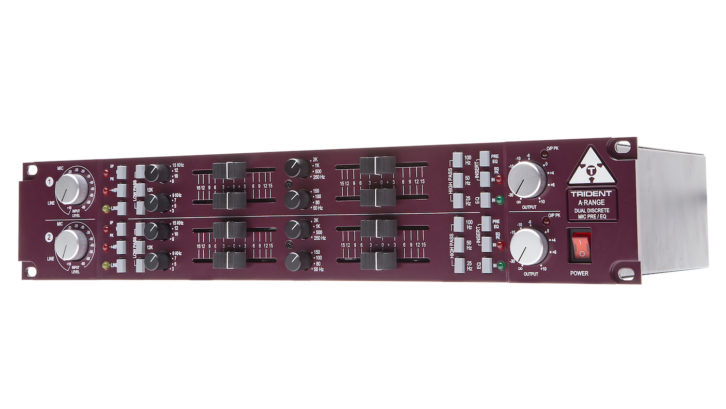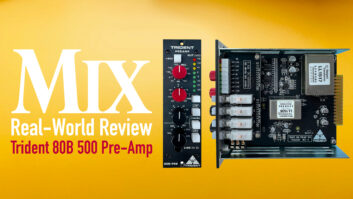
| MIX VERDICT |
| “Overall, I found the Trident A-Range Dual Discrete Mic Pre/EQ to be an excellent-sounding dual-channel system in a class of its own, just like the original Trident A-Range console.” |
| COMPANY: Trident Audio Developments PRODUCT: Trident A-Range Dual Discrete Mic Pre/EQ WEBSITE: www.tridentaudiodevelopments.com PRICE: $4,750 MSRP PROS: Awesome channel that rocks! CONS: I wish the peak LEDs were adjustable. |
The heritage, history and mystique of the new Trident A-Range Dual Channel Strip goes back to the 1960s and ’70s, when Trident Studios in London was hosting legendary recording sessions for bands like The Beatles, Queen, Supertramp, David Bowie, Elton John, T-Rex and many others. Consistently at the leading edge of recording technology, Trident was the first studio in England to employ an Ampex 8-track tape recorder, which was soon updated to a 2-inch, 16-track machine, predating their use at EMI’s Abbey Road Studios.
It was obvious that a new recording console was required to manage the burgeoning world of large multitrack music production, but there were none available, so under the direction of Barry Porter and Trident’s technical staff, the A-Range console was developed around the proven A-Series equalizer.
The four-band A-Series EQ has inductor-based (LC) circuits in the lower and upper mid-band sections. Those channel strips were fully discrete circuits designed and hand-built to the specific needs of the studios.
Rather than following strict and “proper” electronic design criteria, the console was designed based on the preferences of venerable engineer/producers like Roy Thomas Baker, Ken Scott and Tony Visconti, all of whom contributed practical suggestions in its development. One of the company’s earliest advertising slogans was: “designed by recording engineers for recording engineers.”
The Trident A-Range was a multi-bus console with capable monitoring facilities to handle large track counts and multiple monitoring and headphone mixes.
For a variety of reasons, there were only 13 A-Range consoles built back in the 1970s—most of these classics are now rebuilt and still in service today. Despite being more than 40 years old, two rack-mounted A-Range modules with an external power supply sell today for upward of $10,000!
SOLID INSIDE AND OUT
The 2U Trident A-Range Dual Discrete Mic Pre/EQ is as close as possible to a pair of original 1972 Trident console input channel strips. Made in Gardena, Calif., it features the same circuits and component types/values as its predecessor, with (more reliable) Polyshine pots, custom-made rotary switches and E-Switch/Taiwan Alpha pushbuttons.
The A-Range unit is presented in a thick, machined-aluminum front panel with two identical channels positioned one above the other. I liked that the general layout of the console’s vertical-oriented channel strips is identical except that it’s been rotated 90 degrees to fit in two rackspaces. I also love that Trident retained the regal and stately aubergine, or “eggplant,” color just like the consoles back in the day—a color scheme suggested by RTB.
The rear panel has a slightly protruding shielded box to hold the power transformer and the regulated linear power supply, which provides +48 volts and +24 volts DC. There are rear panel XLR connectors for both Line and Mic inputs, and these XLRs are duplicated (paralleled) with quarter-inch TRS jacks. Conveniently, there are also sets of TRS jacks in parallel with the Line output XLRs.
L-Acoustics L-ISA Studio 2.4 – A Real-World Review
PSPaudioware Saturator and Impressor Plug-Ins – A Real-World Review
PreSonus DM-7 Drum Mic Set – A Real-World Review
There are additional pairs of quarter-inch unbalanced Send/Return jacks for inserting audio processors either pre or post the equalizer section. Front-panel switches to select Pre or Post are provided.
Under the hood, I found a metal sub-assembly bracket that holds six transformers—all in mu-metal cans. There are the original (spec) Sowter 3575 line Input and 1460F 600-ohm output isolation transformers (originally, the channel strips had unbalanced outputs). In addition, there are two large custom-wound Cinemag CMMI-5C mic input transformers.
The CMMI-5C is a 1:5 step-up mic transformer based on Ed Reichenbach’s design of the Jensen JT-13K, which originally replaced the out-of-print Zutto Bellclaire models. The Zuttos have a huge peak at 30 kHz, and that was a big part of the original channel’s “je ne sais quoi.” Those Trident A-Range modules have frequency response all the way out to 40 kHz. My own experience from tracking sessions in the ’70s-’80s at Cherokee Studios, L.A.— drums, bass, guitars, keyboards and vocals, using 20 to 30 channels in their Trident A-Range consoles—was that they sounded magnificent!
MADE TO ROCK!
The Trident A-Range’s two Class-A channels are built on separate circuit boards stacked one above the other. The 4-band equalizer uses proportionate-Q peaking circuits for the inductor-based Hi-Mid and Low-Mid bands. They have a broad Q of 1—about 1.3 to 1.4 octaves. The Hi and Low frequency bands are shelving types with 6dB/octave slopes.
One distinctive visual feature of the A-Range console is the four (70mm long) Bournes faders for the 4-band EQ’s boost/cut controls. During a tracking or mixing session, it is easy to scan across an entire A-Range console and check at a glance whatever EQ settings you had going on.
On the new Trident A-Range channel, adjacent to each fader are the custom-made Taiwan Alpha rotary switches to select frequencies, plus large aluminum knobs for the rotary Input gain and the Output level control—again, reminiscent of the A-Range console modules.
Equalizer frequencies are:
- Band 1 at 50, 80, 100 and 150 Hz
- Band 2 at 250 Hz, 500 Hz, 1 kHz and 2 kHz
- Band 3 continues with 3 kHz, 5k, 7k and 9k
- The top band is switchable between 8 kHz, 10k, 12k and 15k
Both the Low Pass and High Pass filters are second-order, with 12 dB/octave curves. The Low Pass filter has 9 kHz, 12k and 15k frequencies, while the High Pass filter has 25, 50 and 100Hz points. Each has associated pushbuttons. I always liked the fader’s center detents, which made it easy to “zero out” and reset the EQ.
IN THE STUDIO
My first use was as a line-level processor for individual mono and stereo tracks. I “toned up”— applying a 0 dB VU from the signal generator in Pro Tools on an insert of the master bus. I set the rotary Line Level input rotary switch to 0 dB—it switches line level in 5 dB steps from +10 dB to -10 dB. Interesting to me is that this rotary switch has 16 positions and rotates continuously through five line-level positions and then 11 microphone gain positions from -15 dB to -65 dB, also in 5 dB steps. There is a Line input switch that changes the strip from the mic XLR input to the line XLR input.
The unit’s Output Line Level is a regular linear pot, and it was right on the 0 dB mark—I usually never change this calibrated position, even when recording. But I liked this variability to exactly match channel outputs. This also means my Pro Tools (-18 dBu) I/O’s calibration is good, and I can start inserting the A-Range on any track(s) in a mix or record directly to the analog inputs of my Crane Song Interstellar ADC/Master Clock.
I immediately tried an old trick: boosting at 50 Hz and at the same time using the 25Hz highpass filter. On kicks and especially bass guitars, it sounds just like the bottom end on those British Rock records I grew up on!

I tried it out on an already-recorded backing vocal stack, and I just love the sound of boosting +6 dB at 15 kHz while also lifting 80 Hz about +3 dB. This is a smooth, broad-sounding musical EQ that was capable of any change I wanted.
Even using exactly the same settings, I was not able to reproduce this sound with a plug-in equalizer—they all sounded too clinical and boring for this rock song.
I also tried the unbalanced inserts. I patched an old MXR Distortion+ pedal into the quarter-inch jacks, and I liked how easy it was to switch the inserted processor Pre or Post EQ from the front panel. I had the Trident A-Range on an electric piano track with an Eventide Tricerachorus pedal creating a swirling sound.
A typical chore for a pair of A-Range modules would be on kick and snare. Right away, I found the Input peak LED to blink with nearly every hit—it is set to +16 dBu (+12VU) measured just before the EQ section, so it reads peaks from either microphones or line-level signals coming into the unit.
The Output LED is set at +10 dBu (6VU)— but the channel will output up to +26 dBu (+22VU) before clip. I wish that these LEDs were adjustable and conveyed a little more information—maybe a bi-colored LED with both pre-clip and hard-clip level indication.
Because I could adjust the input and output levels freely, I ran a stereo drum loop into the unit and tried frequency-sensitive saturation on the channels and compared them to cleaner settings.
I set the Line input level to the least sensitive at +15 dB for the clean setup, and then made up level (just like a compressor) on the Output pot that was set to around +7 dB. I compared that with the same loop, but this time the Input was set at -10 dB and the Output controls were at -10. All peak LEDs were lighting up with every hit, whereas on the clean setup, only the Output LEDs would flash.
I got the same sort of results with a drop-tuned bass guitar; profoundly overloaded and devoid of any attack (pick)—you can do it, but there are lots of boxes or plug-ins that do this well.
VOCAL RECORDING
I recorded vocals using my Bock U195 condenser (cardioid only) set to Normal and followed the Trident with a Retro Instruments 176 compressor set to 4:1, slow attack and fast release. I used the -35 dB mic gain setting and boosted +3 at 15 kHz, with the Output knob at 0 dB. I made up recording level using the 176’s Output knob. I thought this combo with the singer(s) within inches of the mic and pop screen worked great!
The Trident is an honest conveyor of what is presented in front of the mic. I saw no clip LEDs on either the Input or Output. Maximum compression, when I looked at the 176’s meter, was about 6 dB.
I also tried a new Cloud 44 ribbon (passive) mic, and there was plenty of gain for my loud singer available, so no need for the 25 dB of gain from the company’s CL-1 Cloudlifter preamp.
Overall, I found the Trident A-Range Dual Discrete Mic Pre/EQ to be an excellent-sounding dual-channel system in a class of its own, just like the original Trident A-Range console.







